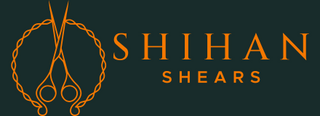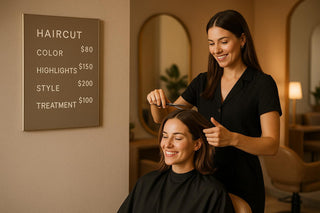Balancing pricing and service value is essential for salons to attract and retain clients. Here's what you need to know:
-
High-End Salon Chains:
- Charge premium prices for a luxury experience.
- Focus on expertise, high-quality tools (e.g., Shihan Shears), and a polished ambiance.
- Offer bundled services and perks like consultations and take-home products.
- Challenges: High costs and maintaining customer flow during economic downturns.
-
Mid-Range Independent Salons:
- Offer flexible pricing and customizable services.
- Emphasize personal attention and community connection.
- Use professional-grade tools to ensure consistent quality.
- Challenges: Limited growth potential and fewer resources for advanced training.
Key Takeaway: Success comes from aligning pricing with perceived value. Investing in quality tools and staff training boosts client satisfaction and justifies pricing, whether you're running a high-end chain or an independent salon.
Quick Comparison:
| Aspect | High-End Salon Chain | Mid-Range Independent Salon |
|---|---|---|
| Pricing | Premium, bundled services. | Flexible, customizable options. |
| Service Quality | Focus on expertise and luxury. | Personal attention and trust-building. |
| Tools & Products | Uniform, top-tier tools (e.g., Shihan Shears). | High-quality tools tailored to stylist needs. |
| Customer Experience | Luxury ambiance, added perks. | Community-focused, owner-operated. |
| Challenges | High costs, economic sensitivity. | Limited scale, fewer training resources. |
Bottom Line: Delivering consistent quality and value is more impactful than pricing alone. Investing in tools like Shihan Shears and training helps salons thrive across price points.
Salon Pricing: Formula for a higher hairstylist service price list
1. High-End Salon Chain
High-end salon chains rely on premium pricing to convey their commitment to exceptional service. Their higher costs are justified by creating a luxury experience through multiple layers of value.
Pricing Structure
These salons charge significantly more for services like haircuts and coloring, but it’s not just about the service itself - it’s about the experience. They bundle offerings such as extended consultations, advanced product applications, specialized treatments, and post-service styling advice. Instead of focusing on individual treatments, they present comprehensive service packages that position the salon as a luxury destination. This approach not only elevates the client experience but also encourages higher spending per visit.
Service Quality
At the heart of these high-end chains is a commitment to expertise. Stylists undergo continuous training to perfect their skills, ensuring clients receive precise cuts, advanced coloring techniques, and tailored styling advice. Consultations are thorough, diving into each client’s lifestyle, hair history, and maintenance preferences. This personalized approach reduces dissatisfaction and builds long-term loyalty, reinforcing the value of their premium pricing.
Product and Tool Standards
When it comes to tools and products, these salons don’t cut corners. They use top-tier equipment like Shihan Shears, prized for their ergonomic design, sharpness, and durability. By sourcing tools from trusted brands, they ensure every cut is executed with precision and care, further upholding their reputation for excellence.
Customer Experience
Every detail of the customer experience is meticulously planned, from the first booking to the final goodbye. These salons create a luxurious environment with carefully chosen lighting, soothing music, plush seating, and elegant décor. Appointments are never rushed, allowing clients to fully enjoy the attentive service. Additional perks like complimentary amenities, in-salon treatments, and take-home styling products add an extra layer of indulgence. All of these elements work together to justify the premium price tag and leave clients feeling pampered and valued.
Next, we’ll explore how these features differ from the approach taken by mid-range salons.
2. Mid-Range Independent Salon
Mid-range independent salons strike a balance between quality and affordability, appealing to a wide range of customers. These salons focus on providing good value without the high price tag often associated with upscale chains.
Pricing Structure
Unlike premium salons, mid-range salons adopt a more flexible pricing approach. They often offer customizable services, allowing clients to select add-ons that fit their budget and preferences. Bundled service options and loyalty programs are common, giving customers the freedom to tailor their experience while keeping costs manageable.
Service Quality
The quality of service in mid-range salons revolves around technical expertise and personalized care. Stylists focus on mastering essential techniques while conducting one-on-one consultations to understand each client’s needs. This personal touch builds trust and fosters long-term relationships, ensuring clients feel valued and understood.
Product and Tool Standards
To maintain consistent service quality, these salons invest in reliable, professional-grade tools. For example, Shihan Shears are a popular choice due to their precision, ergonomic design, and durability. Tools like these help stylists deliver clean, accurate cuts, reinforcing the salon’s commitment to quality.
Customer Experience
Mid-range independent salons often stand out for their personal touch. Many are owner-operated, which means clients interact directly with the salon owner, creating a welcoming and community-oriented environment. While these salons may not offer the luxurious amenities of high-end chains, their focus on personalized attention and efficiency ensures clients feel cared for and appreciated.
sbb-itb-a50b05d
Strengths and Weaknesses Comparison
When analyzing salon business models, it’s clear that each comes with its own set of trade-offs, particularly when it comes to pricing, service quality, and overall value. Let’s take a closer look at how high-end salon chains and mid-range independent salons stack up against each other.
| Aspect | High-End Salon Chain | Mid-Range Independent Salon |
|---|---|---|
| Pricing Strengths | Premium branding supports higher margins and consistent pricing across multiple locations. | Flexible pricing attracts a wider audience, allowing salons to cater to diverse budgets. |
| Pricing Weaknesses | High prices can alienate some customers, especially during economic downturns. | Lower margins make profitability more challenging, and creating a luxury image may be difficult. |
| Service Quality Strengths | Standardized training ensures consistent service and access to the latest industry trends. | Personalized attention, owner involvement, and close client relationships enhance the customer experience. |
| Service Quality Weaknesses | Service may feel less personal, and frequent staff turnover can disrupt continuity. | Limited resources for advanced training can lead to inconsistencies, particularly with staffing changes. |
| Value Proposition Strengths | Delivers a full luxury experience with strong brand recognition and prestige. | Builds loyalty through community connections and a focus on value-for-money services. |
| Value Proposition Weaknesses | High expectations demand constant investment, and premium pricing can be hard to sustain in a shifting market. | Growth is often restricted by operational scale, as expanding without losing the personal touch is a challenge. |
This comparison highlights how each model addresses pricing, service quality, and value in unique ways. High-end salon chains thrive on higher margins but face steep costs from premium rents, extensive marketing, and luxurious amenities. These factors make them particularly vulnerable when customer traffic slows.
On the other hand, mid-range salons benefit from lower overhead costs and more flexible operations, which often lead to strong local customer loyalty. However, their growth potential can be limited by the difficulty of scaling while maintaining their personal, community-focused approach.
Investment in tools and equipment also varies. High-end chains often prioritize uniformity, negotiating bulk deals to maintain brand consistency across locations. Independent salons, free from corporate constraints, can focus on high-quality tools like Shihan Shears (https://shihanshears.com), which enhance service quality and cater to individual stylist preferences.
Customer retention strategies differ as well. High-end chains rely on brand consistency to keep clients coming back, while independent salons build loyalty through personalized service and strong relationships.
When it comes to growth, chains have the advantage of scaling quickly with standardized systems. Independent salons, however, often grow at a steadier pace, though scaling up can risk losing the personal touch that defines their appeal.
Conclusion
Success in the salon industry isn't just about setting the right prices - it's about delivering value that aligns with those prices. The real challenge lies in finding ways to elevate service quality without significantly increasing costs.
For salon owners, the path forward involves identifying opportunities to improve service value. Balancing consistency and personalization is crucial, as each pricing model comes with its own set of trade-offs. One effective way to bridge this gap is through investing in professional-grade tools and equipment. Unlike larger chains that often focus on uniformity through bulk purchases, independent salons have the flexibility to select tools that directly enhance the customer experience. For example, premium tools like Shihan Shears can make a noticeable difference in service quality.
When stylists use top-tier tools, they can achieve cleaner cuts, more precise techniques, and faster service times. These improvements not only boost customer satisfaction but also justify slightly higher prices. Customers are often willing to pay more when they see tangible benefits in the services they receive.
Additionally, research shows that customer retention has a greater impact on profitability than initial pricing strategies. Whether you run a boutique salon or a high-end chain, investing in quality tools and ongoing training helps deliver consistent, superior service. This approach builds long-term loyalty and ensures that pricing reflects the value provided, rather than relying solely on branding or cost-cutting.
Ultimately, salon owners need to bridge the gap between what they charge and the value they deliver. By focusing on strategic investments in tools, training, and service improvements, salons can create a sustainable foundation for growth and profitability.
FAQs
How can independent salons stay competitive with high-end chains while keeping prices affordable?
Independent salons have a real opportunity to shine by focusing on personalized service, fostering strong connections within their community, and delivering high-quality, tailored experiences that prioritize value instead of relying on luxury branding. Many clients are drawn to the unique charm and welcoming vibe that independent salons can offer - something larger chains often miss.
To stay affordable while staying competitive, try strategies like targeted local marketing - think engaging on social media, optimizing for local SEO, and setting up referral programs. Additionally, investing in tools or products that improve service quality without driving up costs can make a big difference. By blending outstanding service with smart marketing efforts, salons can build a loyal client base that appreciates both quality and reasonable pricing.
What are the best ways for salons to invest in tools and training to increase service value and support their pricing?
Salons can enhance their service offerings and justify premium pricing by using top-tier tools like professional shears, ergonomic styling chairs, and high-end hair care products. These tools don’t just last longer - they also improve precision and help deliver better results, ensuring clients leave with a polished and satisfying experience.
Equally important is investing in ongoing training for stylists. Advanced skills in areas like balayage, color correction, or scalp treatments keep the team sharp and aligned with the latest industry trends. Regular education not only elevates the quality of services but also demonstrates the salon’s dedication to staying ahead, fostering trust and loyalty among clients.
Why is retaining salon clients more profitable than focusing on initial pricing strategies?
Focusing on keeping your current clients happy often brings in more profit than simply relying on pricing strategies to attract new ones. Why? Because loyal customers typically have a higher lifetime value (LTV) - they spend more over time. In fact, even a modest 5% increase in customer retention can lead to profit growth of up to 95%.
On top of that, holding onto existing clients is much more cost-effective. Bringing in new customers can be 5 to 25 times more expensive than retaining the ones you already have. By building trust and loyalty with repeat clients, you not only secure a steady revenue stream but also enhance your reputation, setting the stage for sustainable growth and success.

